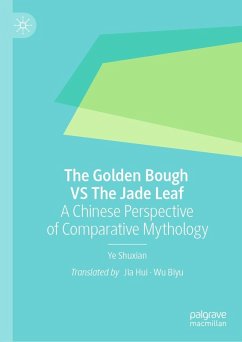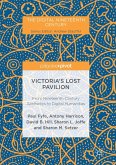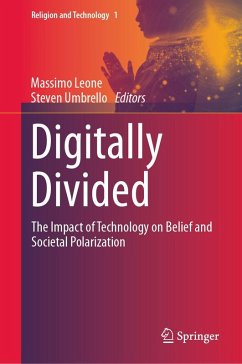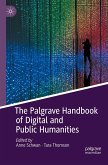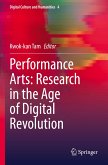Ye ShuxianA Chinese Perspective of Comparative Mythology
The Golden Bough Vs the Jade Leaf
A Chinese Perspective of Comparative Mythology
Übersetzung:Hui, Jia; Biyu, Wu
Ye ShuxianA Chinese Perspective of Comparative Mythology
The Golden Bough Vs the Jade Leaf
A Chinese Perspective of Comparative Mythology
Übersetzung:Hui, Jia; Biyu, Wu
- Gebundenes Buch
- Merkliste
- Auf die Merkliste
- Bewerten Bewerten
- Teilen
- Produkt teilen
- Produkterinnerung
- Produkterinnerung
This landmark volume offers a bold response from the East to the Western classic The Golden Bough, bringing Chinese perspectives into the global conversation on comparative mythology.
Through a close examination of the culturally distinctive motif of the Jade Leaf , the author reinterprets the foundational narratives of ancient China and highlights the symbolic and civilizational role of jade in shaping East Asian identity. By bridging disciplines such as mythology, literature, history, philosophy, religion, art, and anthropology, the book constructs a uniquely Chinese mythological coding…mehr
Andere Kunden interessierten sich auch für
![The Sinograph in Digital Language Art The Sinograph in Digital Language Art]() Yue-Jin HoThe Sinograph in Digital Language Art119,99 €
Yue-Jin HoThe Sinograph in Digital Language Art119,99 €![Victoria's Lost Pavilion Victoria's Lost Pavilion]() Paul FyfeVictoria's Lost Pavilion42,99 €
Paul FyfeVictoria's Lost Pavilion42,99 €![Digitally Divided Digitally Divided]() Digitally Divided151,99 €
Digitally Divided151,99 €![The Cognitive Humanities The Cognitive Humanities]() The Cognitive Humanities83,99 €
The Cognitive Humanities83,99 €![The Palgrave Handbook of Digital and Public Humanities The Palgrave Handbook of Digital and Public Humanities]() The Palgrave Handbook of Digital and Public Humanities174,99 €
The Palgrave Handbook of Digital and Public Humanities174,99 €![Performance Arts: Research in the Age of Digital Revolution Performance Arts: Research in the Age of Digital Revolution]() Performance Arts: Research in the Age of Digital Revolution129,99 €
Performance Arts: Research in the Age of Digital Revolution129,99 €![Bookshelves in the Age of the COVID-19 Pandemic Bookshelves in the Age of the COVID-19 Pandemic]() Bookshelves in the Age of the COVID-19 Pandemic83,99 €
Bookshelves in the Age of the COVID-19 Pandemic83,99 €-
-
-
This landmark volume offers a bold response from the East to the Western classic The Golden Bough, bringing Chinese perspectives into the global conversation on comparative mythology.
Through a close examination of the culturally distinctive motif of the Jade Leaf , the author reinterprets the foundational narratives of ancient China and highlights the symbolic and civilizational role of jade in shaping East Asian identity. By bridging disciplines such as mythology, literature, history, philosophy, religion, art, and anthropology, the book constructs a uniquely Chinese mythological coding system one that challenges conventional boundaries and offers fresh insight into the spiritual and cultural imagination of ancient China.
Through a close examination of the culturally distinctive motif of the Jade Leaf , the author reinterprets the foundational narratives of ancient China and highlights the symbolic and civilizational role of jade in shaping East Asian identity. By bridging disciplines such as mythology, literature, history, philosophy, religion, art, and anthropology, the book constructs a uniquely Chinese mythological coding system one that challenges conventional boundaries and offers fresh insight into the spiritual and cultural imagination of ancient China.
Produktdetails
- Produktdetails
- Verlag: Fudan University Press / Palgrave Macmillan / Springer Nature Singapore / Springer, Berlin
- Artikelnr. des Verlages: 89257966, 978-981-95-2350-4
- Seitenzahl: 362
- Erscheinungstermin: 1. Januar 2026
- Englisch
- Abmessung: 210mm x 148mm
- ISBN-13: 9789819523504
- ISBN-10: 9819523508
- Artikelnr.: 75159356
- Herstellerkennzeichnung
- Libri GmbH
- Europaallee 1
- 36244 Bad Hersfeld
- gpsr@libri.de
- Verlag: Fudan University Press / Palgrave Macmillan / Springer Nature Singapore / Springer, Berlin
- Artikelnr. des Verlages: 89257966, 978-981-95-2350-4
- Seitenzahl: 362
- Erscheinungstermin: 1. Januar 2026
- Englisch
- Abmessung: 210mm x 148mm
- ISBN-13: 9789819523504
- ISBN-10: 9819523508
- Artikelnr.: 75159356
- Herstellerkennzeichnung
- Libri GmbH
- Europaallee 1
- 36244 Bad Hersfeld
- gpsr@libri.de
Ye Shuxian, a Ph.D. holder in Comparative Literature, is a senior professor at Shanghai Jiaotong University, China. He is the chairman of the Chinese Mythology Association and Chinese Comparative Literature Association. He was a visiting professor at the Yale University from 1999 to 2000 and the director of Comparative Literature in the Chinese Academy of Social Sciences from 2004 to 2012. His main areas of research include comparative literature, mythology and literary anthropology. He has published more than 300 journal articles and over 40 books.
Part One: The Encoding and Decoding of Mythological History.- Chapter 1: Jade Myths and Chinese Identity.- Chapter 2: The Big Tradition and the Small Tradition of Chinese Culture.- Chapter 3: The Chinese Mythistory: From Chinese Myths to Mythological China .- Chapter 4: From Nüwa to the Female Frog: The Creation Myth and the Background of the Frog God in China.- Chapter 5: New Origins of Daoist Thought: New Archaeological Materials Reveal Updated Mythological Origins of Daoist Thought.- Chapter 6: The Mythology of Xi Wangmu (the Queen Mother of the West): The Legacy of Goddess Civilization in China.- Chapter 7: The Bear Totem and Prehistoric Mythology in Northeast Asia.- Chapter 8: Chinese Tiger Culture: An Illustration.- Chapter 9: The Globalization of the Lion God and the Metamorphosis of the Bear God: A Visual Diary from a Study Trip in Europe.- Part Two Jade Age and Jade Myths.- Chapter 10: Examining the Sorcerous Roots of Confucian and Daoist Thought from the Mythological Perspective of the Jade Worship.- Chapter 11: From Youxiong to Taiyi: Exploring the Origins of Confucian Mythology through the Quadruple-Evidence Method.- Chapter 12: Sumerian Lapis Lazuli Myths.- Chapter 13: A Comparative Study of the Prototypes of the Tree of Life in the Garden of Eden, the Auspicious Tree in India, and Liuli in China: the Significance of Sumerian Lapis Lazuli Myths in the Origins of Civilization.- Chapter 14: Golden Sound and Jade Vibration: Re-discovery of Confucian Mythology.- Chapter 15: The Origins and Symbolism of Jade Burial Suit.- Chapter 16: Jade Stool, Jade Table and Jade Pillow.- Part Three Literary Anthropology and Cultural Re-Enlightenment.- Chapter 17: Disaster and Salvation in Literature.- Chapter 18: From World Literature to Literary Anthropology: The Contemporary Transformation of Literary Concepts.- Chapter 19: Revisiting Neo-Mythologism: A Critique of Academic Neglect in the Reinterpretation of Mythology in China.- Chapter 20: Avatar and the Quest for Cultural Roots.- Chapter 21: Cultural Re-Enlightenment: The Need for a Discipline Providing a Theoretical Foundation for the Cultural Industry.
Part One: The Encoding and Decoding of Mythological History.- Chapter 1: Jade Myths and Chinese Identity.- Chapter 2: The Big Tradition and the Small Tradition of Chinese Culture.- Chapter 3: The Chinese Mythistory: From Chinese Myths to Mythological China .- Chapter 4: From Nüwa to the Female Frog: The Creation Myth and the Background of the Frog God in China.- Chapter 5: New Origins of Daoist Thought: New Archaeological Materials Reveal Updated Mythological Origins of Daoist Thought.- Chapter 6: The Mythology of Xi Wangmu (the Queen Mother of the West): The Legacy of Goddess Civilization in China.- Chapter 7: The Bear Totem and Prehistoric Mythology in Northeast Asia.- Chapter 8: Chinese Tiger Culture: An Illustration.- Chapter 9: The Globalization of the Lion God and the Metamorphosis of the Bear God: A Visual Diary from a Study Trip in Europe.- Part Two Jade Age and Jade Myths.- Chapter 10: Examining the Sorcerous Roots of Confucian and Daoist Thought from the Mythological Perspective of the Jade Worship.- Chapter 11: From Youxiong to Taiyi: Exploring the Origins of Confucian Mythology through the Quadruple-Evidence Method.- Chapter 12: Sumerian Lapis Lazuli Myths.- Chapter 13: A Comparative Study of the Prototypes of the Tree of Life in the Garden of Eden, the Auspicious Tree in India, and Liuli in China: the Significance of Sumerian Lapis Lazuli Myths in the Origins of Civilization.- Chapter 14: Golden Sound and Jade Vibration: Re-discovery of Confucian Mythology.- Chapter 15: The Origins and Symbolism of Jade Burial Suit.- Chapter 16: Jade Stool, Jade Table and Jade Pillow.- Part Three Literary Anthropology and Cultural Re-Enlightenment.- Chapter 17: Disaster and Salvation in Literature.- Chapter 18: From World Literature to Literary Anthropology: The Contemporary Transformation of Literary Concepts.- Chapter 19: Revisiting Neo-Mythologism: A Critique of Academic Neglect in the Reinterpretation of Mythology in China.- Chapter 20: Avatar and the Quest for Cultural Roots.- Chapter 21: Cultural Re-Enlightenment: The Need for a Discipline Providing a Theoretical Foundation for the Cultural Industry.

